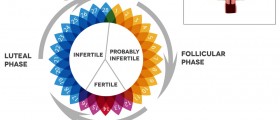
The luteal phase is named after the corpus luteum, which in Latin means yellow body. It symbolizes a structure that grows on the surface of the ovary where a mature egg was released at ovulation. This yellow body produces progesterone, and is preparing the body for pregnancy. In average woman s luteal phase is approximately 14 days long, and fertility specialists say that luteal phase that is between 10 and 16 days long is still considered normal for healthy for pregnancy. Length of luteal phase varies significantly form woman to woman, however, for the same woman the length of luteal phase may be quite stable in every menstrual cycle.
Despite the facts that luteal phase with 10 days is still considered a healthy one, women with luteal phase that is shorter than 12 days may find it harder to get pregnant, while women who have luteal phase shorter than 10 days, are considered to have luteal phase defect and definitely considerable problems with getting pregnant. Women with luteal phase defect hear the words no one ever want to hear: you are infertile . This is because luteal phase defect interferes with the implantation of embryos.
Luteal phase defect is also considered if progesterone levels during the luteal phase are below normal, despite the fact the length of luteal phase is average. If you have been wondering what exactly is happening during luteal phase, here is the explanation. When ovulation ends, the pituitary hormones FSH (Follicle-stimulating hormone) and LH (Luteinizing hormone also known as lutropin) cause the remaining parts of the dominant follicle to transform into the corpus luteum, or said above yellow body (yellow structure). Corpus luteum continues to grow after ovulation and also produces significant amounts of progesterone, and much smaller amount of estrogen. Progesterone is the hormone that plays a main role in making the endometrium receptive to implantation of the blastocyst. Progesterone is also the hormone that is supportive of the early pregnancy, this is the reason that women with luteal phases shorter than 10 days have trouble conceiving.
Progesterone is also the hormone that is responsible for raising the woman's basal body temperature. If you want to determine the lengths of your luteal phase, the only way to do so is with the use of hormone-specific blood tests, otherwise you can only assume it is 14 days long, which is as said above the average length of luteal phase for most women.
















Your thoughts on this
Loading...